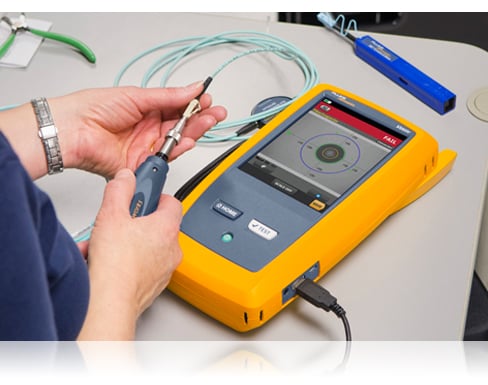Ways fibre testing equipment ensures signal quality
All You Need to Find Out About Robotic Vision and Its Applications in Advanced Optical Dimension Solutions
Robotic vision represents a considerable development in the crossway of computer system vision, expert system, and artificial intelligence. This innovation boosts the accuracy of optical dimension systems, making it possible for real-time information analysis and improved top quality control. Its influence spans several industries, from manufacturing to healthcare. The developing landscape of robotic vision elevates inquiries concerning future capabilities and applications. What developments lie in advance in this transformative field?
Recognizing Robotic Vision: Key Concepts and Technologies
Robotic vision includes the innovations and methods that allow makers to analyze and recognize aesthetic info from their atmosphere. This field combines aspects of computer system vision, fabricated intelligence, and equipment discovering to help with automatic decision-making based on visual data. Key principles include image handling, which includes the improvement and analysis of photos to remove meaningful functions, and object recognition, which allows equipments to determine and identify things within a scene.

The Integration of Robotic Vision With Optical Dimension Systems
As industries significantly require precision and effectiveness, the assimilation of robot vision with optical measurement systems has actually become a transformative technique. This harmony permits robots to perceive and analyze their environments, enhancing the ability of optical dimension systems to analyze and assess objects with unparalleled precision. By equipping optical sensing units with innovative imaging modern technologies, robotic vision allows real-time information collection and processing, facilitating instant adjustments to measurement criteria.
The mix equips automated systems to find variations in measurements, surface area quality, and alignment, which are vital in top quality control processes. Enhanced algorithms, such as artificial intelligence, additional augment this assimilation by enhancing the systems' capacity to adapt to various atmospheres and situations. The combination not just improves dimension procedures yet also lessens errors, making certain that products satisfy stringent market standards, thus strengthening the function of robot vision in the future of optical dimension systems.
Applications of Robotic Vision in Production
In modern-day manufacturing environments, making use of vision systems has changed production procedures by allowing devices to carry out jobs with exceptional accuracy and speed. Robotic vision systems are progressively used for quality assurance, where they check items for issues and guarantee adherence to specs. These systems use cams and progressed algorithms to examine items in real-time, substantially minimizing the threat of human mistake.
In addition, robotic vision facilitates automation in production line, enabling robotics to properly determine components and construct them with very little downtime. This innovation additionally improves inventory monitoring, as vision systems can monitor supply levels and spot disparities, assuring a smooth supply chain.
Furthermore, robotic vision help in the execution of additional info clever factories, where data from vision systems can be integrated with other modern technologies to maximize workflows. Overall, the applications of robotic vision in manufacturing show its essential function in improving effectiveness, quality, and performance across numerous sectors
Robotic Vision in Healthcare: Reinventing Person Care

In rehabilitation, robotic vision aids in monitoring person progress and tailoring therapy sessions to individual needs. It sustains doctor by automating tasks such as information collection and client surveillance, permitting more time to concentrate on direct individual communication. Furthermore, robot vision enhances telemedicine by making it possible for remote diagnosis and digital examinations, bridging the gap in between clients and doctor. Overall, the application of robotic vision in healthcare is transforming additional resources individual treatment, bring about enhanced end results, effectiveness, and individual satisfaction.
Future Patterns and Developments in Robotic Vision Innovation
The rapid evolution of robotic vision modern technology promises to even more boost its applications across numerous industries, consisting of medical care. Future patterns suggest a significant change in the direction of including expert system and artificial intelligence, making it possible for systems to gain from substantial datasets and boost precision with time. Enhanced sensing unit technologies and deep learning algorithms are expected to fine-tune things recognition capabilities, permitting robots to analyze complex atmospheres more successfully.

Additionally, the integration of my site increased truth (AR) with robot vision will likely revolutionize just how robots aid in surgeries and diagnostics. This synergy will assist in real-time information visualization, boosting decision-making processes. Furthermore, miniaturization of components will lead to even more portable and versatile robotic vision systems appropriate for a selection of jobs. As these advancements unfold, sectors will certainly witness boosted automation and efficiency, solidifying robotic vision as a foundation of ingenious technical remedies.
Often Asked Concerns
What Are the Key Components of a Robot Vision System?
The major components of a robot vision system include video cameras for picture capture, processors for data evaluation, formulas for analysis, and actuators for motion. With each other, these elements allow robotics to view and connect with their atmosphere properly.
Exactly How Does Robotic Vision Improve Accuracy in Measurements?
Robotic vision improves dimension accuracy by using advanced imaging modern technologies, enabling precise things discovery and spatial analysis. This capacity minimizes human mistake, enhances repeatability, and enables real-time modifications, inevitably enhancing total measurement reliability and efficiency.
What Industries Benefit A Lot Of From Robotic Vision Modern Technology?
Various sectors benefit greatly from robotic vision innovation, consisting of production, health care, farming, and logistics. These sectors use boosted accuracy, performance, and automation, bring about boosted performance and minimized functional expenses in their corresponding procedures.
Can Robotic Vision Systems Job in Low-Light Issues?
Robotic vision systems can certainly function in low-light conditions, making use of advanced sensing units and algorithms to improve photo clearness. This capability allows them to carry out effectively in numerous environments, consisting of industrial and surveillance applications, despite having marginal lighting.
What Are the Prices Associated With Applying Robotic Vision?
The expenses linked with carrying out robot vision vary considerably, influenced by parts such as electronic cameras, software, and integration. Extra expenditures consist of upkeep, training personnel, and prospective upgrades to existing systems, which can accumulate gradually.